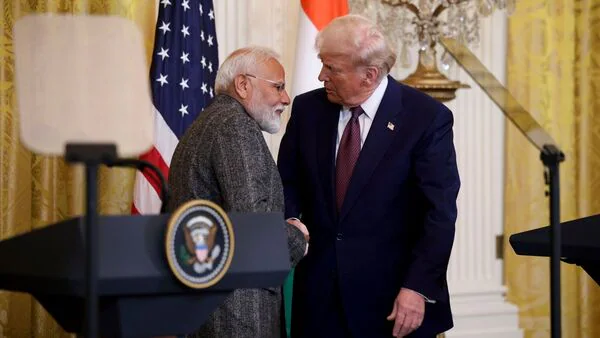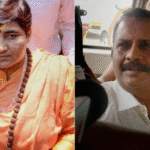Trump Slaps 25% Tariffs on India, Cites Russian Oil Dealings
When Allies Turn Adversarial
In a stunning move that rattled global trade corridors and foreign policy establishments alike, former U.S. President Donald J. Trump — currently the presumptive Republican nominee for the 2024 U.S. Presidential elections — announced sweeping tariffs of 25% on all major Indian imports starting August 1, 2025. Just as shockwaves from his announcement reverberated across New Delhi’s corridors of power, Trump dropped a second hammer: economic penalties on India for continuing to purchase discounted crude oil from Russia, a longtime strategic partner for the South Asian powerhouse.
In a campaign-style rally held in Pennsylvania on July 29, Trump referred to India as a “friend who doesn’t act like one,” arguing that Washington’s generosity over the decades had been repaid with “economic betrayal.” The penalties, he stated, would remain in place “until India respects America-first trade and energy policies.”
India, one of the U.S.’s most significant strategic partners in Asia and a cornerstone of Washington’s Indo-Pacific strategy, now finds itself on uncertain terrain — caught between economic nationalism from a returning Trump and its own need to safeguard affordable energy and domestic manufacturing growth.
This is Part 1 of an in-depth, multi-part journalistic breakdown that will explore the ramifications of this decision: the background, India’s strategic oil calculus, the historical arc of Indo-U.S. trade tensions, the implications for the global economy, diplomatic fallout, and how this could reshape the 21st-century alliance system.
The Announcement That Shook Two Democracies
It was supposed to be another routine campaign rally — part of Trump’s relentless return to the national stage. But as the crowd cheered and MAGA hats waved, Trump’s pivot toward India caught many observers off-guard.
“You can’t call yourself a friend of the United States while buying cheap oil from Putin,” Trump declared, pointing directly at India. “You can’t benefit from our markets and then undermine our sanctions. So we’re putting a 25% tariff on Indian goods starting August 1. And yes — penalties are coming for their energy dealings.”
The impact was immediate. Stock prices of Indian exporters — especially in sectors like textiles, pharmaceuticals, and information technology — dipped in after-hours trading. The Indian rupee also took a slight hit against the dollar, while Indian policymakers scrambled to prepare a formal response.
Strategic Oil: India’s Energy Dilemma
To understand the motivations behind India’s continued Russian oil purchases, one must first examine the geopolitical reality New Delhi faces. Unlike the U.S., India imports over 85% of its crude oil needs. After the outbreak of the Russia-Ukraine war, global oil prices surged, leading to inflationary pressures that risked derailing India’s post-COVID recovery.
When Russia began offering discounted crude to willing buyers, India — much like China — took the opportunity. It was a pragmatic decision, not a political one. Indian foreign policy operates on a principle of strategic autonomy, not binary allegiances.
From India’s standpoint, buying discounted oil from Moscow allowed the country to:
- Keep domestic fuel prices stable
- Protect its current account deficit
- Support post-pandemic economic recovery
- Maintain independence in foreign policy
The United States, particularly under Biden, initially tolerated this approach due to its need to keep India on board with the broader Indo-Pacific strategy to counter China. But Trump has never been one to tolerate deviation from his “America First” ethos, regardless of strategic complexities.
Economic Stakes: What 25% Tariffs Actually Mean
According to the Office of the United States Trade Representative (USTR), India exported over $92 billion worth of goods to the U.S. in 2024, including:
- Pharmaceuticals and generics
- Apparel and textiles
- Software services
- Automotive components
- Agricultural products
A 25% tariff could have a crippling effect, especially on MSMEs (micro, small, and medium enterprises) that depend heavily on U.S. markets. India’s software services industry — already feeling the heat of increased scrutiny over H1B visas — may face tougher compliance barriers.
For context, a similar 25% tariff levied on Chinese goods in 2018 led to a sharp contraction in export volume in several categories, despite initial expectations of resilience.
Historical Flashbacks: Trump and India, Redux
This is not the first time Trump has taken a hard stance on India.
Back in 2019, during his first presidential term, the Trump administration withdrew India’s preferential trade status under the Generalized System of Preferences (GSP), citing lack of reciprocal market access. At that time, India responded by imposing retaliatory tariffs on U.S. goods such as almonds and apples.
The current move appears to be a continuation — or rather, an escalation — of that earlier posture. While India and the U.S. repaired ties under President Biden, the return of Trump — even before assuming power — signals a potentially stormy phase in Indo-U.S. economic relations.
New Delhi Reacts: Silence, Then Calculations
Within hours of the announcement, officials in India’s Ministry of External Affairs and Ministry of Commerce began closed-door consultations. According to diplomatic sources, India’s initial strategy is to avoid escalating tensions publicly and to await clarification from Washington.
However, the Prime Minister’s Office (PMO) is said to be considering:
- Formal protest via diplomatic channels
- A review of oil import strategies
- Exploring fast-track diversification of export destinations
- Potential appeal to WTO against unilateral tariffs
India’s external affairs minister Dr. S. Jaishankar is expected to issue a formal statement in the coming days, after a broader inter-ministerial consultation.
The Russia Angle: A Red Line for Trump
Trump’s specific mention of Russia wasn’t a coincidence. As part of his broader effort to restore American “global dominance,” Trump has criticized both Democrats and U.S. allies for not taking strong enough actions against Moscow.
Ironically, during his presidency, Trump was often accused of being soft on Russia. But in this latest posture, he seems eager to portray himself as a leader who demands loyalty and obedience from allies, especially in economic and strategic arenas.
India, for its part, has maintained time-tested defense and energy ties with Russia, ranging from the S-400 air defense system to oil and gas investments. It does not view the relationship as a zero-sum game — a reality Trump seems unwilling to accept.
A New Test for Strategic Friendship
Trump’s latest tariffs mark more than just an economic decision — they represent a stress test for the evolving Indo-U.S. relationship. While many in Washington have long seen India as a democratic counterweight to China, Trump’s transactional approach threatens to unravel years of diplomatic progress.
India must now decide whether to absorb the economic hit, negotiate a compromise, or retaliate diplomatically and economically. But one thing is clear: the “friendship” narrative is being put to the test in the harshest terms yet.
How the Ukraine War Rewired Energy Strategy
India’s decision to continue importing Russian oil at discounted rates wasn’t made in a vacuum. It was the outcome of shifting geopolitical tectonics, where national interest — not ideology — dictated action. After the Russia-Ukraine conflict escalated in early 2022, energy markets worldwide went into turmoil. For oil-importing nations like India, the ripple effects were direct, painful, and politically volatile.
With the global price of Brent crude crossing $120 per barrel in mid-2022, India’s oil import bill soared, threatening inflation and squeezing household budgets. At that crucial moment, Russia emerged as an alternative supplier — offering discounts of up to $30 per barrel below global benchmarks. For New Delhi, this wasn’t a political endorsement of Moscow’s war. It was, simply put, economic necessity.
By the end of 2023, Russia had surpassed Iraq and Saudi Arabia to become India’s largest supplier of crude oil, accounting for nearly 38% of India’s total imports — a staggering rise from less than 2% before 2022. Payment was often routed through rupee-dirham-ruble mechanisms, bypassing the U.S. dollar where possible, and allowing Indian refiners to save billions in foreign exchange.
Indian policymakers justified the move on three counts:
- Price Stability: Cheaper oil helped tame inflation and keep fuel prices domestically affordable.
- Strategic Autonomy: India maintained its tradition of non-alignment, refusing to let global blocs dictate policy.
- Energy Security: With long-term deals and consistent supply, India ensured its energy grid remained stable.
While Western countries sanctioned Russian energy, India argued that developed economies couldn’t expect developing nations to bear the costs of a war they didn’t start — or the energy burdens they couldn’t afford.
The American Lens: Allies or Freeriders?
To understand why Trump’s outburst gained traction domestically, one must examine how the American electorate views international partnerships. A recurring theme in Trump-era foreign policy is the belief that the United States has been taken advantage of — economically, militarily, and diplomatically — by allies who don’t reciprocate American support.
India, though often praised by Washington as a “natural ally,” has never fit neatly into America’s alliance frameworks. Its refusal to condemn Russia at the UN, and its independent foreign policy choices, often jar with traditional U.S. expectations. While Biden’s administration embraced multilateralism, Trump’s view is unapologetically transactional.
From Trump’s standpoint, India:
- Benefited from U.S. markets without lowering trade barriers
- Took advantage of U.S. military support in the Indo-Pacific without aligning policies
- Profited from Russian energy deals while U.S. sanctions went ignored
It’s a worldview shaped less by diplomacy and more by deal-making — one where friendships are evaluated on balance sheets, not shared values.
How Trade Tariffs Could Backfire on the U.S.
While Trump’s rhetoric may appeal to his voter base, economists warn that blanket tariffs on Indian goods could harm U.S. businesses and consumers too.
Key Sectors at Risk in the U.S.:
- Pharmaceuticals: India is the world’s largest producer of generic drugs. U.S. healthcare depends heavily on low-cost Indian APIs and generics.
- IT Services: Indian IT firms provide essential backend and cloud services to Fortune 500 companies. A disruption could raise operational costs.
- Automotive Components: Indian firms supply affordable parts used by American auto manufacturers. Tariffs could raise vehicle assembly costs.
- Textiles and Apparel: India’s affordable clothing exports keep American retail chains stocked at competitive prices.
In 2019, when Trump had imposed duties on Indian steel and aluminum, U.S. importers had to absorb higher costs — some of which were passed on to American consumers.
This time, the scope is broader — and so are the stakes.
China’s Geopolitical Windfall
While Trump seeks to punish India for its defiance, the biggest beneficiary of this rift may not be American factories, but Chinese ambitions.
As U.S.-India economic ties fray, China sees a strategic opening:
- In Trade: China could recapture market share in sectors like electronics, textiles, and components where India had begun to displace it.
- In Diplomacy: India may be forced to hedge harder toward BRICS and SCO forums, where China plays a dominant role.
- In Influence: ASEAN nations, witnessing this spat, may reconsider aligning too closely with U.S. interests.
Ironically, Trump’s tariffs — intended to protect American interests — could accelerate the geopolitical decoupling between India and the West, pushing India deeper into Eurasian strategic frameworks.
Domestic Fallout: Modi Government Under Pressure
Back home, Prime Minister Narendra Modi’s administration now faces a delicate balancing act.
On one hand, India can’t afford to let U.S. tariffs crush its exports — especially with unemployment and inflation still sensitive issues. On the other, capitulating to U.S. pressure on Russian oil could be politically disastrous. Modi has championed energy affordability as part of his pro-poor governance model. Raising fuel prices to appease Washington would hand ammunition to opposition parties.
Furthermore, with national elections due in 2026, the ruling BJP government cannot be seen as weak on foreign policy or trade negotiations. Modi’s political brand is built on strength and sovereignty. A climbdown may carry domestic political costs.
Sources within the Ministry of Commerce suggest that India may file a complaint at the World Trade Organization (WTO) if Washington proceeds with unilateral tariffs. India could also explore countermeasures on select U.S. imports — including agricultural goods, almonds, and Harley-Davidson motorcycles — which were targeted during the 2019 tariff spat.
Experts Weigh In: Will the Crisis Escalate?
We reached out to trade and foreign policy experts to understand the road ahead.
Dr. Swati Bhandarkar, a trade economist at Jawaharlal Nehru University, warns:
“If the tariffs are implemented, expect a contraction in export earnings, especially for SMEs. The cost of compliance with U.S. customs will rise sharply.”
Lt. Gen. (Retd.) Rakesh Bhatia, a former Indian Defense Attaché in Washington, says:
“This is more about optics than substance. Trump is playing to his base. But if he wins the presidency again, we must prepare for a more adversarial economic environment.”
Michael Dawson, former U.S. Trade Counsel, notes:
“Targeting India might feel politically useful in the short term, but it weakens a key bulwark in the Indo-Pacific. China will benefit if this continues.”
Fault Lines Deepen
What began as a strategic disagreement over energy is rapidly morphing into a full-blown economic flashpoint between two of the world’s largest democracies. Trump’s tariffs — and the penalties tied to India’s Russian oil purchases — signal a departure from nuanced diplomacy and a return to brute-force transactionalism.
India, meanwhile, must brace for turbulent waters. Balancing its energy needs, its trade interests, and its geopolitical partnerships will demand diplomatic dexterity and economic resilience. But one thing is increasingly clear: the Indo-U.S. partnership, long considered a pillar of 21st-century cooperation, is now being tested like never before.
Indian Industries in the Crosshairs
As the clock ticks down to August 1, the day Trump’s 25% tariffs on Indian imports take effect, business leaders across India are bracing for impact. The magnitude of this decision isn’t limited to diplomatic circles — it directly threatens India’s export economy, with thousands of MSMEs (Micro, Small and Medium Enterprises), exporters, and manufacturers exposed to the United States market.
In 2024, India’s exports to the U.S. totaled approximately $92 billion, making it India’s largest export destination. The 25% blanket tariff — if fully enforced — will affect nearly 60% of these goods, ranging from life-saving generic drugs to high-end software services.
Let’s examine the top sectors most vulnerable:
1. Pharmaceuticals and Generics
India supplies more than 40% of the generic drugs consumed in the United States. These include essential medications for cholesterol, diabetes, blood pressure, and even cancer treatments. Indian drugmakers like Sun Pharma, Dr. Reddy’s, and Cipla stand to lose significantly if their products become 25% more expensive overnight.
While U.S. authorities are unlikely to allow shortages of essential drugs, procurement prices will rise, and many hospital systems and insurance providers will feel the pressure. Indian pharma companies fear losing contracts and market share to alternative producers in Eastern Europe or the domestic U.S. market.
2. Information Technology Services
India’s IT sector — the pride of its service economy — will not face direct tariffs on software, but indirect restrictions may emerge. Trump’s previous administration was hostile toward H-1B visa holders, and many fear a repeat.
Indian firms such as Infosys, TCS, Wipro, and HCL Technologies rely on thousands of on-site U.S. workers. If Trump targets immigration or imposes digital service taxes, IT contracts could dry up, and global competitiveness may suffer.
3. Textiles and Apparel
Apparel exports from India to the U.S. reached over $9 billion last year. For small-scale weavers and textile exporters, the American market is not just vital — it’s irreplaceable. A 25% increase in price will make Indian garments less attractive compared to those from Vietnam, Bangladesh, and even Mexico.
The Knitwear Cluster in Tiruppur, Tamil Nadu — which alone contributes over ₹30,000 crore annually in garment exports — has already begun appealing to the central government for relief packages and contingency plans.
4. Automotive and Engineering Components
Indian engineering goods, especially auto parts and industrial components, have found robust demand in the U.S. market due to their low cost and high quality. Companies like Bharat Forge, Sundaram Fasteners, and Motherson Sumi are likely to see their U.S. clients rethink procurement strategies.
Trump’s tariffs will disrupt existing supply chains, and Tier-2 and Tier-3 suppliers may not survive the shock without government intervention.
India’s Counter-Options: Retaliation or Realignment?
While New Delhi is attempting to contain the fallout diplomatically, sources suggest the Indian government is preparing a multi-track response.
1. WTO Complaint Under Article XXIII
India is likely to file a formal complaint at the World Trade Organization (WTO), arguing that Trump’s tariff action violates the principle of Most Favored Nation (MFN) treatment and is discriminatory. WTO cases can be protracted, but such a step will at least put formal international pressure on Washington.
2. Targeted Tariffs on U.S. Imports
India may consider retaliatory tariffs on U.S. goods, especially in sectors where it has domestic substitutes. Likely candidates:
- Almonds and Walnuts (California-based industries heavily reliant on India)
- Harley-Davidson Motorcycles (symbolic and politically sensitive)
- U.S. Wines and Spirits
- Agricultural Seeds and Machinery
This tit-for-tat strategy was deployed in 2019, when Trump removed India’s GSP benefits.
3. Deepening Trade Ties Elsewhere
India is accelerating negotiations with the EU, Australia, and the UK for comprehensive free trade agreements (FTAs). With the India–EU FTA in the final leg, India is hoping to cushion the blow of lost U.S. market access by expanding into European and East Asian markets.
Additionally, India could look at expanding intra-BRICS trade, particularly with Brazil and South Africa, where Indian generics, machinery, and textiles have growing demand.
Global Diplomatic Response: Who Stands Where?
Trump’s sudden decision has not gone unnoticed by other global players. While the U.S. domestic media has offered a divided response, the international reaction has ranged from caution to quiet criticism.
European Union (EU)
EU diplomats have expressed concern over Trump’s unilateralism. Brussels has been cautiously supportive of India’s Russia policy, understanding the energy constraints of emerging economies. The EU is watching the tariff saga closely as it finalizes its own FTA with India.
Russia
The Kremlin has viewed Trump’s threat as an opportunity. Spokesperson Maria Zakharova said:
“President Trump has shown once again that America does not tolerate independence in its partners. We welcome India’s resolve to act in its national interest.”
Moscow is reportedly offering more oil cargoes to India at further discounted rates, a move that will only deepen the U.S.-India standoff.
China
Beijing has remained publicly silent but is strategically pleased. The U.S. isolating India — even partially — removes a key pillar of the Indo-Pacific containment strategy. Chinese media outlets such as Global Times have labeled Trump’s move “predictably self-sabotaging.”
OPEC and Energy Markets
Trump’s crackdown on India’s oil imports from Russia has rattled energy markets. Analysts predict that if India is forced to pivot away from Russian crude, global demand for OPEC oil will spike, driving prices upward. This could inadvertently hurt U.S. inflation — an irony not lost on oil analysts.
Will Biden Intervene or Stay Silent?
Although Trump’s announcement was made as a candidate, its impact is real — because markets and foreign governments assume he may return to power. The Biden administration has not formally endorsed Trump’s tariff threat, but it has also not disavowed it.
The silence is telling.
Some believe Biden is quietly benefiting from the global reaction to Trump’s unpredictability. Others say the White House is waiting for diplomatic overtures from India before drawing lines between campaign rhetoric and state policy.
It’s a dangerous ambiguity. The longer the silence continues, the more likely it becomes that Trump’s vision shapes India’s trade environment, even before ballots are cast in November.
Battle Lines Are Drawn
The 25% tariffs and the Russian oil penalties are no longer just a policy threat — they are a diplomatic earthquake, shaking the very foundation of the U.S.–India partnership. Indian industries are already reacting, policymakers are strategizing, and international stakeholders are recalibrating.
As Trump doubles down on his “America First” narrative, India must find a path forward — one that defends national interests without triggering full-scale trade conflict. But one fact is now undeniable: the age of predictable Indo-U.S. cooperation is over. What lies ahead is harder, messier — and full of uncertainty.
Also Read : NISAR Mission Launch Live: NASA-ISRO Earth Observation Satellite Takes Off from Sriharikota on July 30








